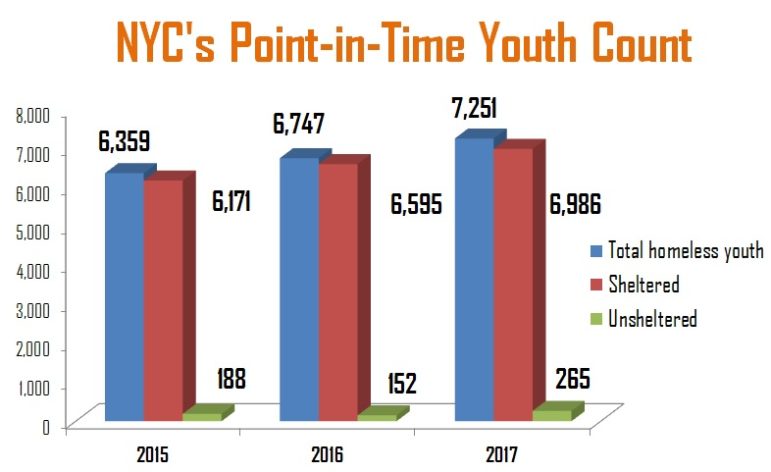
DYCD
Many advocates take issue with the accuracy of the city's official count of youth homeless, but at the very least it provides an indicator of the problem's growth.
Youth homelessness is a tough concept for many people to grasp. Young people can become homeless for a number of different reasons—many leave their current situations because they are running away from abuse, neglect or non-acceptance. Others may have lost a parent or a guardian. And others, while they may not want to leave their homes, can be forced out due to any number of circumstances.
Youth homelessness is steadily growing. According to a report by the Pew Charitable Trusts, San Diego saw a 39 percent jump in homelessness from 2016 to 2017. Meanwhile, in 2016 Atlanta saw three times the number of homeless youths than in previous years. Meanwhile, according to the National Network for Youth, homeless youth were 78 percent more likely to access services like drop-in centers than emergency shelters and one service center even reported that of the youth that stayed over 20 days and entered preparement programs, 60 percent were successfully transitioned into housing.
When I speak about youth homelessness, I am specifically talking about young adults, who are responsible for themselves and for their housing. They are too old to be adopted, yet too young, in my opinion, to have to grow up so fast that they lose any hope of being able to achieve their dreams. They do not have the support of our community as they need or should. Currently, New York City’s Department of Youth and Community Development spends $29.5 million a year combating homelessness but statistics show the number of youth considered homeless is rising exponentially. Clearly, we need to do more. To have the city or state create subsidies for programs, which are focused on youths in school, and include efforts to support schoolwork, would be one place to start.
Many people believe that the only solution to solving youth homelessness is to provide these young people with a place to live. While I do believe that this is a major part of the solution, it is just one part. More than just being given a spot at a shelter, these young men and women need support and opportunity to help them grow. We need more preparement programs like job training, counseling and basic skills computer program skills to be offered in order to help them achieve in school and at work.
Most of the young adult homeless population cannot afford college tuition, let alone consider college an option not because they lack the heart, will, or smarts—but they simply have no idea of how to begin the process of getting into college or unnecessarily doubt themselves. Often these youths are lost in large urban schools with crowded classrooms and overly worked guidance counselors and teachers who they look to in hopes for assistance to navigate through these processes. We need more funding towards the programs, teachers, and counselors helping these students. The city needs to create ways to encourage the inclusion of educational and vocational schooling in shelters and housing or incentivize the hiring of tutors or teachers after hours to work with the youth population living in shelters. We need to show our youth that every single one of them matters, and give them the opportunity to grow out of ‘homelessness’.
I have seen many amazing youth homeless shelters enact these types of “stepping stones,” which include providing next-step housing and offering things like tuition waivers, legal clinics offering advice and assistance and programs preparing youth to live independently. The goal of these programs is to offer youths options to better themselves through education, access to job training programs/tools which eventually helps transition them to the next level in their lives. Ultimately, through programs like these, young people are set up to be able to stand on their own two feet.
The number of people across the U.S. who rent, as opposed to buy, will continue to increase by 500,000 or more annually, over the next 10 years. It is my hope to see this number increase even more with the inclusion of homeless youth moving to the next steps in their lives and being able to afford paying rent. Providing the right tools to this group, including the ability to live in affordable housing, will help allow them to thrive in their independence and realize the opportunities that exist outside the walls of a shelter. To put the cost of living, with most of that burden being rent, on a young individual who is already fighting to afford to eat, makes it nearly impossible for him or her to succeed.
While I applaud those organizations that are currently enacting “stepping stones” for homeless youth, more organizations need to be created to continue these transitions from the streets and shelters to free market. I’m confident and hopeful in the progress they will achieve if these educational and vocational programs are expanded.
Today’s youth is tomorrow’s future – homeless youth most definitely must be included here.
Heidi Burkhart, founder and president of Dane Real Estate, is a 14-year veteran of the real estate industry and has facilitated closings in excess of 11,500 affordable housing units and over $1.6 billion in transactions.








